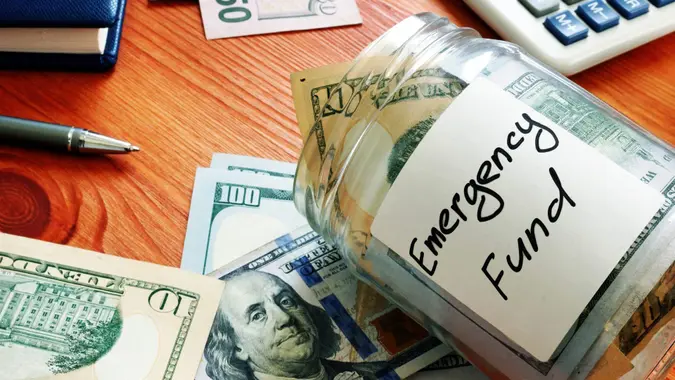Advertiser Disclosure
GOBankingRates works with many financial advertisers to showcase their products and services to our audiences. These brands compensate us to advertise their products in ads across our site. This compensation may impact how and where products appear on this site. We are not a comparison-tool and these offers do not represent all available deposit, investment, loan or credit products.
8 Savings Mistakes That Are Costing You Big Money
 Written by
Nicole Spector
Written by
Nicole Spector
 Edited by
Molly Sullivan
Edited by
Molly Sullivan

Commitment to Our Readers
GOBankingRates' editorial team is committed to bringing you unbiased reviews and information. We use data-driven methodologies to evaluate financial products and services - our reviews and ratings are not influenced by advertisers. You can read more about our editorial guidelines and our products and services review methodology.

20 YearsHelping You Live Richer

Reviewed by Experts

Trusted by Millions of Readers
You don’t need to know much about finances to know how important it is to save money. Most CPAs and CFPs recommend having at least three months’ worth of emergency savings in the bank — a figure that for many is hard to reach, with millions of Americans unable to cover a $1,000 unplanned expense.
In general, the less you have saved up in cash, the more you’ll end up blowing in credit card debt. It’s a vicious cycle that can feel impossible to break.
While we know how crucial saving money is, we may not always know the best ways to save it. We may be even less aware of the fact that there are indeed bad ways to save. Yes, just as with spending, we can err when saving — even when our intentions are good. Here’s a look at the most common mistakes that finance professionals see Americans making everyday.
Failing to Begin
“The biggest savings mistake people make is failing to start saving,” said Elle Kaplan, CEO and founding partner of LexION Capital, who recommends the 50-30-20. “50% of each paycheck goes to bills and necessities, 30% to ‘wants,’ and 20% should be saved and put into an investment account. This works so well because it makes the process of spending less and saving more both simpler and therefore less painful.”
This method also should prove helpful because it provides a clear and steady strategy that doesn’t require any advanced math skills.
“You save effortlessly without feeling deprived by having a constant focus on budgeting and penny-pinching,” Kaplan said. “Set up a regular transfer to occur as soon as your paycheck hits, to make saving the key 20% easy and automatic.”
Saving as an Afterthought
“One mistake I see people make when trying to make progress towards a savings goal is to only think about savings after they’ve done all their spending for the month,” said Matt Morris, a financial planner with Sanderling Finance, LLC. “If you wait and only save whatever happens to be left over, it’s hard to be consistent.”
Morris recommends thinking of savings as a mandatory monthly expense, just like you would an electricity or Wi-Fi bill.
“Automate the process by creating a recurring monthly transfer to savings each month and try to only spend what remains,” Morris said. “You can start with a smallish amount at first, and then increase the monthly savings as you get comfortable with a more constrained budget. Over time, you should see your savings grow more consistently.”
Keeping Your Savings in One Account
“Assuming you have been able to get into the habit of saving, congrats; but, if you’re like most people, you might be having your savings going into one account,” said Josue Dubon, CFP and founder at DesignWealth. “If you’re working towards different goals and they’re all flowing into one account, it can be difficult to track how much is dedicated to each. Every time you decide to withdraw from your savings account, the possibility of you unknowingly spending money for another goal is incredibly high.”
To solve this potential problem, divide your savings into smaller buckets that can be easier to track.
“Rather than setting aside savings into one account, open up multiple accounts — ideally ones that won’t charge a fee — and begin to allocate,” Dubon said. “How you allocate is up to you, but what is important is that you’re now able to clearly identify what is dedicated to each goal. What we’re doing is introducing the behavioral economics concept of partitioning that is intended to create small barriers, causing a consumer to consider their options and be presented with a new decision point.”
Using a Low-Yield Savings Account
“A lot of savings account products in banks offer very low interest rates, which only depreciates the value of the money you store into it,” said David Levi, founder of Cryptoner. “The truth about saving in banks with low interest rates is that your money depreciates over time — unless you put it in a high-yield savings account where it will surely earn generous interest.”
Saving Too Much and Investing Too Little
“The biggest savings mistake people make is leaving too much money in their checking and savings account,” said Dewan Farhana, founder of Doctor Finances. “You only need about 3-6 months of an emergency fund in a high-yield savings account, and the rest of the money should be invested. Investing your money rather than saving it is really important for mainly two reasons: It helps fight inflation and also helps your money grow with market returns. Investing your money is the best way to grow wealth for the long term.”
Saving While Living on Borrowed Money
“Saving while living on borrowed money is (a) saving mistake people make,” said Lucia Jensen, CEO of WeLoans. “It is equal to lying to yourself, especially by relying on credit cards, loans and overdrafts to pay bills. I consider it a hindrance because, no matter how much you put into the savings account, you still counter it through your expenditure. You spend what you don’t own, which is bad behavior since you only increase your debts. If you can’t control it sooner, the debt could be more than what you have as savings and may not be easy to recover.”
A better way is to create a reliable budget detailing your expenses so you can always review and track your money — and reel in excessive spending before it happens.
“A detailed budget can also help figure out areas to chop and change to let you save money,” Jensen said.
Having Inaccessible Savings
It can be difficult to manage money on a tight budget, which is why it’s important not to make the mistake of depositing your cash in an account with a penalty for early withdrawal. Not only will you not be able to withdraw money during an emergency situation, but you’ll even incur additional fees as well.
In case of emergency situations, always have 3-6 months of savings in a standard savings account.
Buying Low-Cost Items in Order to Save More
“People frequently believe that the greatest way to save money is to buy whatever has the lowest price,” said Matthew Dailly, managing director at Tiger Financial. “While this method may work in some cases, the actual secret to saving money is knowing to buy whatever is the better bargain.
“Buying inexpensive tools that will only last a year or two instead of spending double as much for equipment that will last a lifetime may cost you more in the long term since they will need to be replaced frequently.
“Another example: Instead of buying a cheap cereal containing lots of sugar and very little nutrients, invest in a nutritious cereal that costs a bit more and keeps you healthier.”
Share This Article:




You May Also Like


Here's How Much Money Each Generation Saved in 2024 -- How Do Your Savings Compare?
December 05, 2025
7 min Read




The Most Failed Money Resolutions -- and How Experts Say To Make Real Behavior Change
December 05, 2025
7 min Read






Dave Ramsey and 2 More Experts Discuss Where They Draw the Line on Tipping
December 02, 2025
7 min Read

I'm a Budgeting Expert: How I Save Big on Phone Plans, Even With an iPhone
December 01, 2025
7 min Read

How the Chinese '4-Column Method' Can Help You Save Your First $10K, According to Humphrey Yang
November 30, 2025
7 min Read

Make your money work for you
Get the latest news on investing, money, and more with our free newsletter.
By subscribing, you agree to our Terms of Use and Privacy Policy. Unsubscribe at any time.


Thanks!
You're now subscribed to our newsletter.
Check your inbox for more details.



Sending you timely financial stories that you can bank on.
Sign up for our daily newsletter for the latest financial news and trending topics.
For our full Privacy Policy, click here.
Looks like you're using an adblocker
Please disable your adblocker to enjoy the optimal web experience and access the quality content you appreciate from GOBankingRates.
- AdBlock / uBlock / Brave
- Click the ad blocker extension icon to the right of the address bar
- Disable on this site
- Refresh the page
- Firefox / Edge / DuckDuckGo
- Click on the icon to the left of the address bar
- Disable Tracking Protection
- Refresh the page
- Ghostery
- Click the blue ghost icon to the right of the address bar
- Disable Ad-Blocking, Anti-Tracking, and Never-Consent
- Refresh the page



